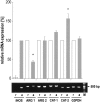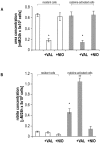Arginase 1 overexpression in psoriasis: limitation of inducible nitric oxide synthase activity as a molecular mechanism for keratinocyte hyperproliferation
- PMID: 12507903
- PMCID: PMC1851107
- DOI: 10.1016/S0002-9440(10)63811-4
Arginase 1 overexpression in psoriasis: limitation of inducible nitric oxide synthase activity as a molecular mechanism for keratinocyte hyperproliferation
Abstract
Abnormal proliferation of keratinocytes in the skin appears crucial to the pathogenesis of psoriasis, but the underlying mechanisms remain unknown. Nitric oxide (NO), released from keratinocytes at high concentrations, is considered a key inhibitor of cellular proliferation and inducer of differentiation in vitro. Although high-output NO synthesis is suggested by the expression of inducible NO synthase (iNOS) mRNA and protein in psoriasis lesions, the pronounced hyperproliferation of psoriatic keratinocytes may indicate that iNOS activity is too low to effectively deliver anti-proliferative NO concentrations. Here we show that arginase 1 (ARG1), which substantially participates in the regulation of iNOS activity by competing for the common substrate L-arginine, is highly overexpressed in the hyperproliferative psoriatic epidermis and is co-expressed with iNOS. Expression of L-arginine transporter molecules is found to be normal. Treatment of primary cultured keratinocytes with Th1-cytokines, as present in a psoriatic environment, leads to de novo expression of iNOS but concomitantly a significant down-regulation of ARG1. Persistent ARG1 overexpression in psoriasis lesions, therefore, may represent a disease-associated deviation from normal expression patterns. Furthermore, the culturing of activated keratinocytes in the presence of an ARG inhibitor results in a twofold increase in nitrite accumulation providing evidence for an L-arginine substrate competition in human keratinocytes. High-output NO synthesis is indeed associated with a significant decrease in cellular proliferation as shown by down-regulation of Ki67 expression in cultured keratinocytes but also in short-term organ cultures of normal human skin. In summary, our data demonstrate for the first time a link between a human inflammatory skin disease, limited iNOS activity, and ARG1 overexpression. This link may have substantial implications for the pathophysiology of psoriasis and the development of new treatment strategies.
Figures





Comment in
-
Explaining decreased nitric oxide production in psoriatic lesions: arginase 1 overexpression versus calcitonin gene-related peptide.Am J Pathol. 2003 Dec;163(6):2642; author reply 2642-3. doi: 10.1016/s0002-9440(10)63621-8. Am J Pathol. 2003. PMID: 14633638 Free PMC article. No abstract available.
References
-
- Schön MP, Ruzicka T: Psoriasis: the plot thickens. Nat Immunol 2001, 2:91. - PubMed
-
- Schlaak JF, Buslau M, Jockum U, Hermann E, Girudt M, Gallati H, Meyer zum Büschenfelde KH, Fleischer B: T cells involved in psoriasis vulgaris belong to the Th1 subset. J Invest Dermatol 1994, 102:145-149 - PubMed
-
- Bruch-Gerharz D, Ruzicka T, Kolb-Bachofen V: Nitric oxide in human skin: current status and future prospects. J Invest Dermatol 1998, 110:1-7 - PubMed
-
- Krischel V, Bruch-Gerharz D, Suschek C, Kroencke KD, Ruzicka T, Kolb-Bachofen V: Biphasic effect of exogenous nitric oxide (NO) on proliferation and differentiation in skin-derived keratinocytes but not fibroblasts. J Invest Dermatol 1998, 111:286-291 - PubMed
Publication types
MeSH terms
Substances
LinkOut - more resources
Full Text Sources
Other Literature Sources
Medical
Research Materials
Miscellaneous

